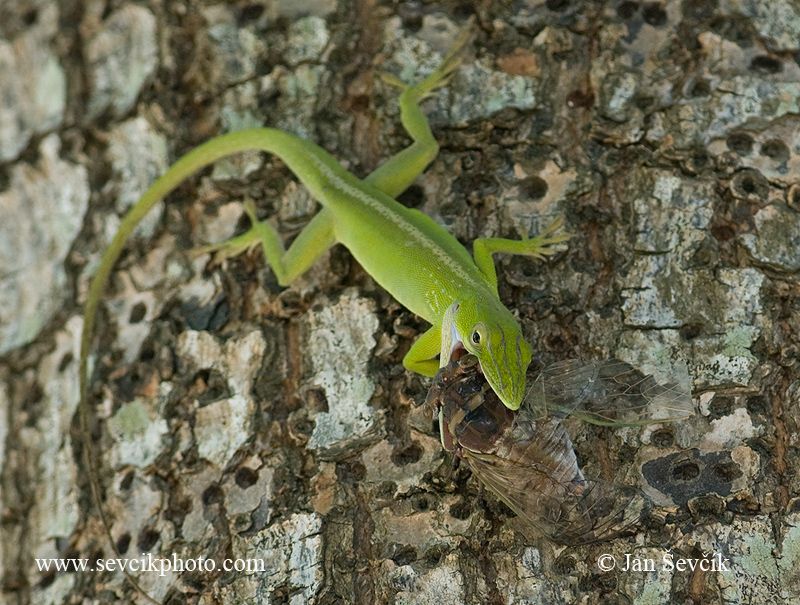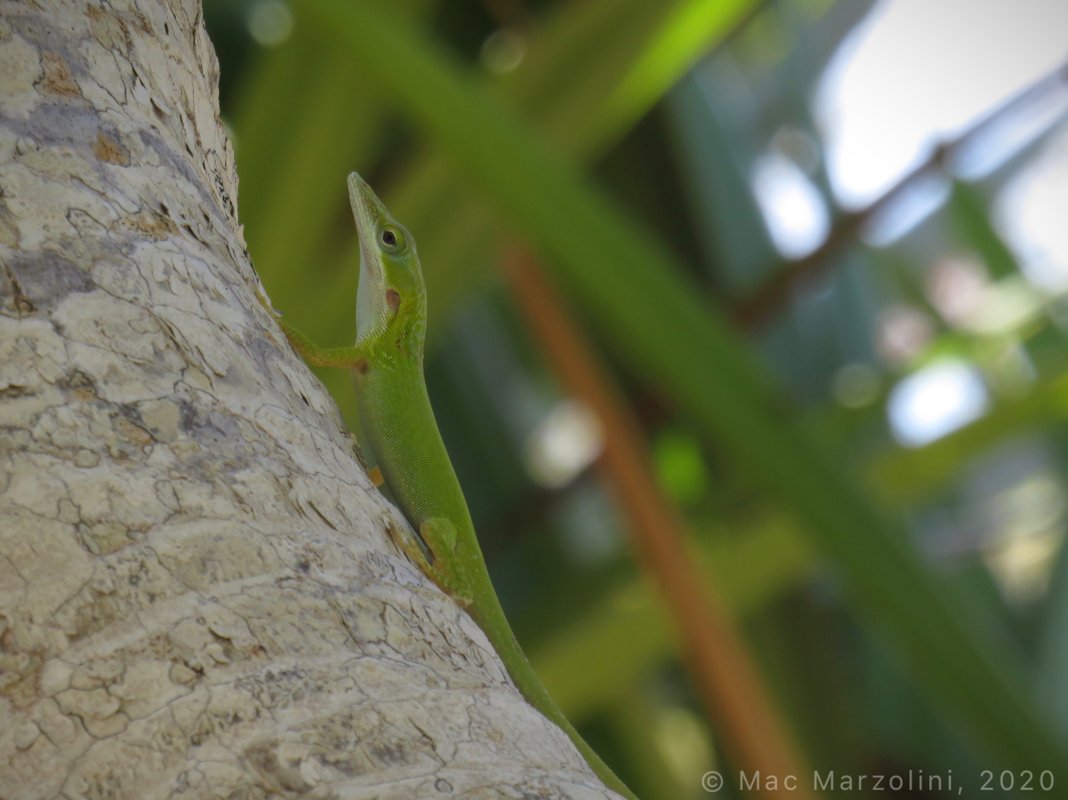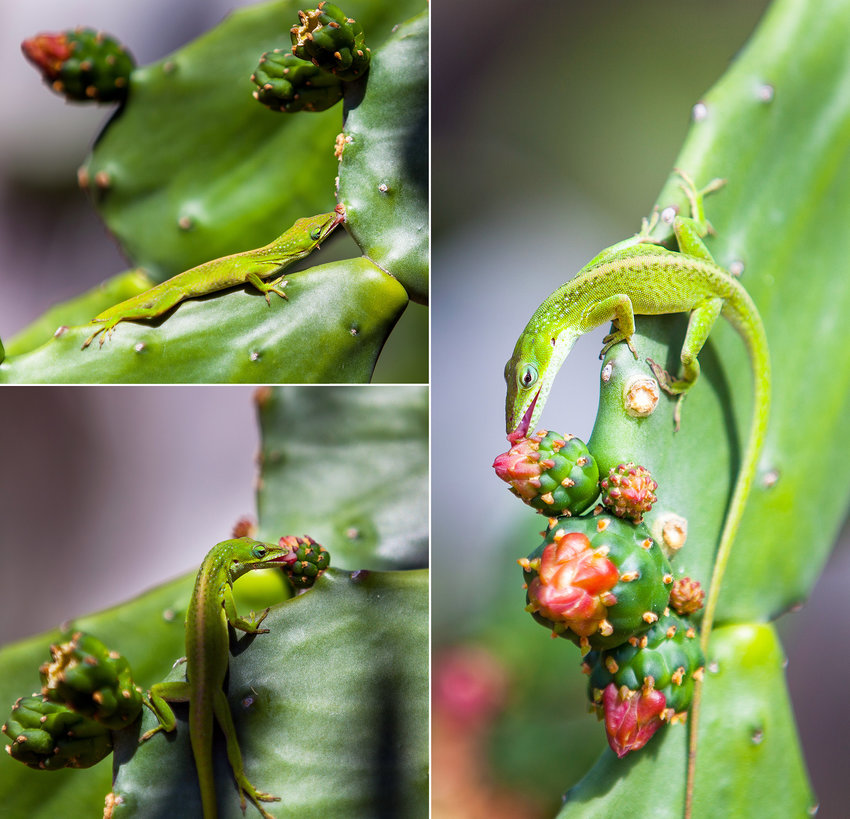
Figure 1. Knight anoles (Anolis equestris) are large, arboreal, and highly frugivorous lizards native to Cuba and introduced to Miami, Florida in the mid-20th century. This adult female was found perched on the trunk of a strangler fig (Ficus aurea) in Miami, Florida, a common sight in south Florida. Strong jaws and a large gape enable knight anoles to consume a range of large food items including snails, locusts, small vertebrates (occasionally), and some moderate-sized fruit. Photo by S. Giery.
I remember the first knight anole (Anolis equestris) I ever caught. Details about how I caught it are gone, but I certainly remember the resulting bloody thumb. I was impressed and intrigued by the force and stamina of its bite – I needed to study this critter (fig. 1). Motivated by the recent publication of a short paper on knight anole diets, below, I break down a few years of research into the trophic ecology of the knight anole into a brief recount of what my collaborators and I have found.
Preliminary observations on knight anole trophic ecology
Following that first encounter I conducted a simple study of anole diet and habitat use around the Florida International University (FIU) campus in North Miami. In general, the findings showed some sensible results: Cuban brown anoles (A. sagrei; trunk-ground) perched low and ate a wide variety of terrestrial insects, Hispaniolan bark anoles (A. distichus; trunk) skittered up and down the trunk and ate – almost exclusively – ants, and Cuban knight anoles (A. equestris; crown-giant) ate larger food items than the other two species and tended to stay in the canopy (Giery et al. 2013). Again, this pattern of diet and habitat use was expected except for one thing – the composition of knight anole diet. Prior to embarking on the study, I had expected, based on their large size, strong bite force, the abundance of smaller anoles, and a few anecdotal accounts, that these powerful lizards would be eating lots of anoles. Surely these were the T-Rex of the trees and their direct interaction with other anoles was a predatory one. Yet in all the knight anoles that I dissected in this first study (n =21), not a single one contained vertebrate remains. Instead, nearly half of the diet (by volume) was fruit, specifically strangler figs (Ficus aurea; look to Supplemental table 1 for summary diet data). Our stable isotope data corroborate these observations – rather than the enriched 15N signature we‘d expect from an anole predator, the isotope data suggested similar trophic levels for brown, bark, and knight anoles. So what gives? Where was the evidence for a swaggering, arboreal meat-a-saurus?
Years later, James Stroud and I assessed the stomach contents of more knight anoles (n = 10) from a different site in Miami (Fairchild Tropical Botanic Gardens. James had directly observed knight anoles eating three different species of anoles there (1,2,3,4) and so we thought another look at their diet would be interesting. Once again, the majority of gut contents consisted of fruit, this time from royal palm trees (Roystonea regia). In fact the only evidence for vertebrate prey in this population was a 1 cm section of green anole tail. These data supported earlier observations (Brach 1976; Dalrymple 1980, Giery et al. 2013) demonstrating that fruit is a major component of knight anole diet, and vertebrates aren’t. It seemed that the canopy superpredator role I’d imagined for knight anoles was increasingly less likely. In fact, in all three previous examinations of knight anole diet, few instances of vertebrate predation by knight anoles are observed (table 1). The evidence spoke, knight anoles were sharp-toothed, veggie-sauruses with a deliberate, powerful bite.

An opportunity presents itself
Understanding the trophic ecology of anoles has been an ongoing project of mine for some time, the paper that we’ve just published in Food Webs (Giery et al. 2017) would not have come without the serendipitous post-capture … deposition … of a few seeds. An adult male passed two royal palm seeds which were planted post-haste in the greenhouse at FIU. It took a few months but the seeds eventually geminated, demonstrating that seeds consumed by knight anoles are viable and suggesting a role as seed dispersers (fig 2).

Figure 2. Adult knight anoles (Anolis equestris) often inhabit the crowns of royal palms (Roystonea regia) in Florida and Cuba. Note the numerous ripe fruits above this displaying male photographed at our study site in Coral Gables, Florida (A). Roystonea regia seedlings resulting from seeds passed naturally by a wild-caught A. equestris. Both seeds were planted at the same time, but germinated nearly 130 days apart (B). Adult royal palms can reach 30m high and are an ecologically and economically important plant throughout their range (C). Photos by J. Stroud (A & B) and S. Zona (C).
We felt that these data filled an important gap in our understanding of how anoles interact with other species. Certainly, the literature (e.g., Herrel et al. 2004; Losos 2009) and our data from Florida (Giery et al. 2013, 2017), Bermuda (Stroud, unpublished), and The Bahamas (Giery, unpublished) show that frugivory is widespread and sometimes quite common in anoles. Yet, the fact that seeds remain viable after passing through the guts of anoles presents a new facet to their interactions with plants. For more about what we know about lizard-plant interactions go ahead and check out the references in our paper (there’s good stuff from Europe, and recently, the Galapagos).
Whether the interaction we illustrate in our paper is ecologically important (i.e., increasing germination rates via ingestion and/or dispersal) requires substantially more study. Yet, the relationship between knight anoles and royal palms has been noted for nearly a century in Cuba suggesting their interaction is more widespread than just Florida. For example, Barbour and Ramsden (1919) remarked on the frequent coexistence of royal palm and knight anoles in Cuba. Interestingly, these early works often focused on the potential consumption of vertebrate prey, despite reports from Cubans that knight anoles often ate fruit – a bias matching my own preconceptions about the nature of this great anole:
“As to the food of the great Anolis [equestris] we know but little; it is surely insectivorous and Gündlach records that he once heard the shrill scream of a tree frog Hyla and found that it had been caught by one of these lizards. The country people all declare that they feed largely upon fruit, especially the mango; it is not improbable that this idea arises from the fact that they are frequently found in mango trees. We have always imagined that this circumstance was due in part at least to the excellent cover offered by the splendid growth of rich green foliage of the Cuban mango trees; it, however, has been seen eating berries (Ramsden). With good luck one may occasionally see two males of this fine species chasing one another about, making short rushes and charges at each other, accompanied by much tossing of heads and display of brilliant dewlaps When this mimic battle takes place about the smooth green top of the trunk of a stately Royal Palm, it is a sight not easily forgotten.” from Barbour and Ramsden 1919.
Anyways, we hope our short paper does two things. First, we hope that our summary of knight anole diet in Florida accurately illustrates their trophic ecology. Second, seed dispersal of native trees (royal palm and strangler fig) by an introduced vertebrate represents an interesting contrast to the negative effects usually attributed to introduced species (e.g., brown anole). We hope our observations highlight the diverse relationships between anoles and plants in the Caribbean region. Finally, we realize that our data are merely suggestive and effective seed dispersal by anoles has yet to be demonstrated. Nevertheless, we’re excited by the potential for new research directions stimulated by our observations.
Giery, S.T., Vezzani, E., Zona, S., Stroud, J.T. 2017. Frugivory and seed dispersal by the invasive knight anole (Anolis equestris) in Florida, USA. Food Webs 11: 13-16.




















